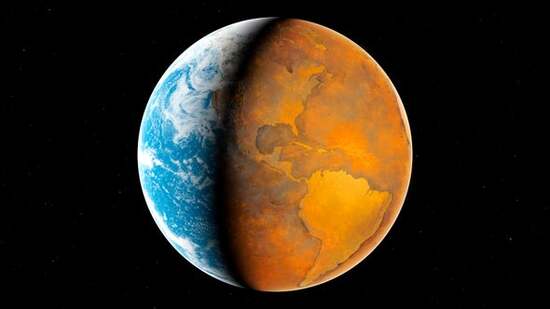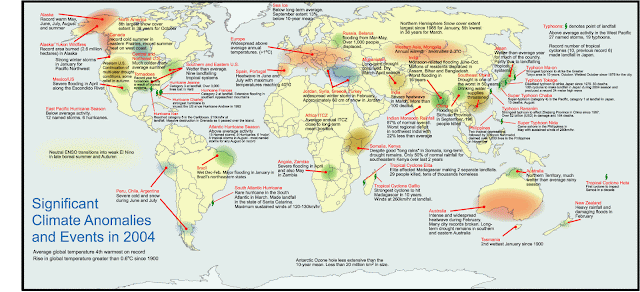2004 World Climate Data
- Atmospheric CO2 concentration: 376.95ppm, +1.80 ppm from 2003
- Surface air temperature anomaly: +0.58°C/1.04°F, 18th all-time 1880-2021
- Precipitation 10.7 mm, ~1% above 1961-1990 global average
- Global mean sea level: 1.75 mm below 1993-2008 average, +1.96 mm from 2003
- ENSO: Neutral through June, weak El Niño from then till year’s end
- Antarctic ozone: annual minimum 138 Dobson units (DU)*, South Pole station
Global Conditions
- Above-average temperatures: South America; European Russia; China; southwest Asia; central Asia; Australia
- Below-average temperatures: Asian Russia
- Drought: southern and norther horn, and southern Africa; Central America; eastern Cuba; northeast, northwest and central east coast China; central Asia; India; eastern and southwestern Australia
- Extreme rain: southwest Asia; Colombia; Brazil; Algeria; equatorial horn of Africa
* The Dobson unit (DU) is a measure of trace gases in the
atmosphere. It is estimated from concentration measurements (satellite and
in-situ). The DU represents the number of 10 um (micrometer, one millionth of a
meter: one one-thousandth of a millimeter) pure layers in the atmosphere the
observed amount of trace gas would form, at standard temperature and pressure (STP:
1 bar, 0°C/32°F). For example, a typical average value for ozone (O3)
is 300 DU, meaning, ozone, if isolated, ozone would form a pure layer of 3000
um (3 mm) at STP around much of the world. 2004’s South Pole station value of
138 DU (1.38 mm) is 46% of this average value. The Antarctic ozone hole is
tracked year-round via measurements across the continent.
The weak late-year El Niño did not prevent an extremely active North Atlantic hurricane season. Meanwhile the South Atlantic experienced its first hurricane (named Catarina) which struck southern Brazil in March. North Pacific cyclone activity fell into two halves: below average in the northeast, above average in the northwest, with 10 cyclones impacting Japan. Australia and the South Pacific also had light hurricane seasons, while the Indian Ocean was average. Madagascar was badly damaged by category 5 supercyclone Gafilo.
Global Mean Sea Level (GMSL), 1900-2018, relative to 1900
Be brave, and be well.









No comments:
Post a Comment